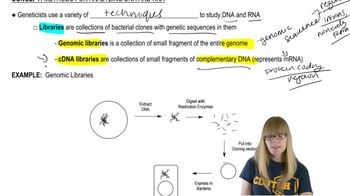Table of contents
- 1. Introduction to Genetics51m
- 2. Mendel's Laws of Inheritance3h 37m
- 3. Extensions to Mendelian Inheritance2h 41m
- 4. Genetic Mapping and Linkage2h 28m
- 5. Genetics of Bacteria and Viruses1h 21m
- 6. Chromosomal Variation1h 48m
- 7. DNA and Chromosome Structure56m
- 8. DNA Replication1h 10m
- 9. Mitosis and Meiosis1h 34m
- 10. Transcription1h 0m
- 11. Translation58m
- 12. Gene Regulation in Prokaryotes1h 19m
- 13. Gene Regulation in Eukaryotes44m
- 14. Genetic Control of Development44m
- 15. Genomes and Genomics1h 50m
- 16. Transposable Elements47m
- 17. Mutation, Repair, and Recombination1h 6m
- 18. Molecular Genetic Tools19m
- 19. Cancer Genetics29m
- 20. Quantitative Genetics1h 26m
- 21. Population Genetics50m
- 22. Evolutionary Genetics29m
18. Molecular Genetic Tools
Methods for Analyzing DNA
Problem 17a
Textbook Question
Textbook QuestionA hereditary disease is inherited as an autosomal recessive trait1. The wild-type allele of the disease gene produces a mature mRNA that is 1250 nucleotides (nt) long. Molecular analysis shows that the mature mRNA consists of four exons that measure 400 nt (exon 1), 320 nt (exon 2), 230 nt (exon 3), and 300 nt (exon 4). A mother and father with two healthy children and two children with the disease have northern blot analysis performed in a medical genetics laboratory. The results of the northern blot for each family member are shown here. Based on your analysis, what is the most likely molecular abnormality causing the disease allele?
 Verified Solution
Verified SolutionThis video solution was recommended by our tutors as helpful for the problem above
Video duration:
2mPlay a video:
176
views
Was this helpful?
Related Videos
Related Practice

